Creative journaling offers numerous calming techniques to help manage anxiety. You can create gratitude collages, practice mindful doodling, or design affirmation lettering pages. Nature-inspired watercolor spreads and emotion color coding systems provide visual ways to express feelings. Writing exercises focused on worry release can help process anxious thoughts. Crafting positive memory scrapbook pages allows you to revisit joyful moments. Mindfulness mandalas and zentangles promote relaxation through intricate designs. Developing a self-care routine planner helps prioritize your well-being. These journaling ideas combine artistic expression with emotional release, offering a powerful toolkit for anxiety relief. Explore these techniques to discover which ones resonate most with you.
Gratitude Collage Pages
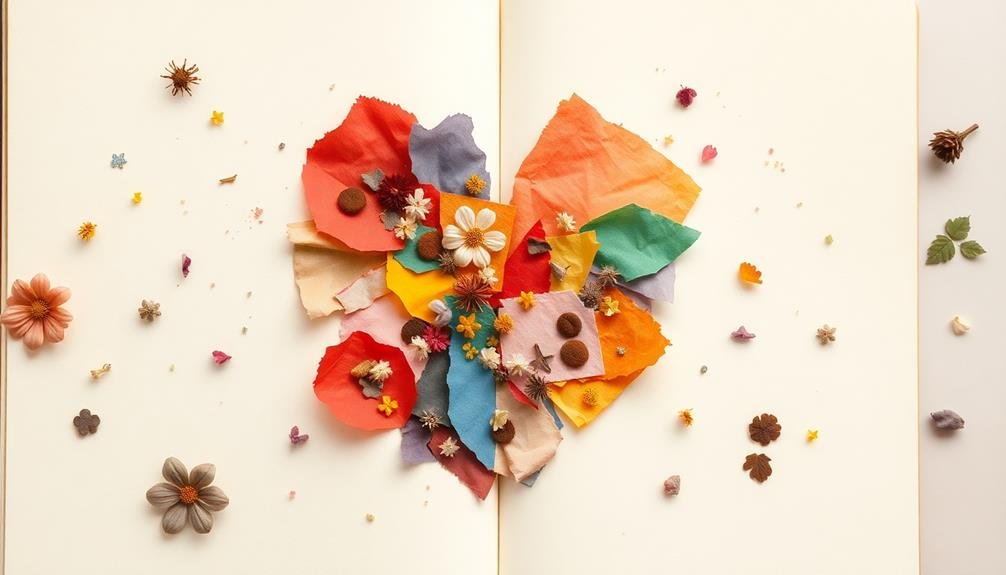
One powerful way to combat anxiety through journaling is by creating gratitude collage pages. This technique combines visual art with mindfulness, helping you focus on the positive aspects of your life.
To start, gather old magazines, newspapers, photos, and colorful paper. As you flip through these materials, look for images and words that represent things you're grateful for.
Cut out these elements and arrange them on a blank journal page, creating a vibrant collage. Don't worry about perfection; let your intuition guide you. As you assemble your collage, reflect on each item and why it brings you joy or gratitude. This process helps shift your mindset from anxiety-inducing thoughts to appreciation for life's blessings.
You can create themed gratitude collages, such as "people I'm thankful for" or "simple pleasures." Alternatively, make a general collage that encompasses various aspects of your life.
Once complete, write a brief description next to each element, explaining its significance. Revisit these pages when you're feeling anxious to remind yourself of the good in your life and regain perspective.
Mindful Doodling Exercises
Have you ever considered doodling as a mindfulness practice? Mindful doodling exercises can be a powerful tool for anxiety relief, combining the benefits of artistic expression with focused attention.
To begin, set aside a few minutes each day and grab your journal and a pen. Start by drawing a simple shape, like a circle or spiral, and let your pen flow without judgment or planning.
As you doodle, focus on the sensation of the pen against the paper and the lines forming beneath your hand. If your mind wanders, gently bring your attention back to the act of drawing. Try creating patterns, repeating shapes, or filling in spaces with intricate designs. You can also experiment with different themes, such as nature-inspired doodles or abstract patterns.
Another approach is to use doodling as a way to visualize your emotions. Draw shapes or lines that represent how you're feeling, allowing the pen to move intuitively. This can help you process and release anxious thoughts.
Affirmation Lettering Practice
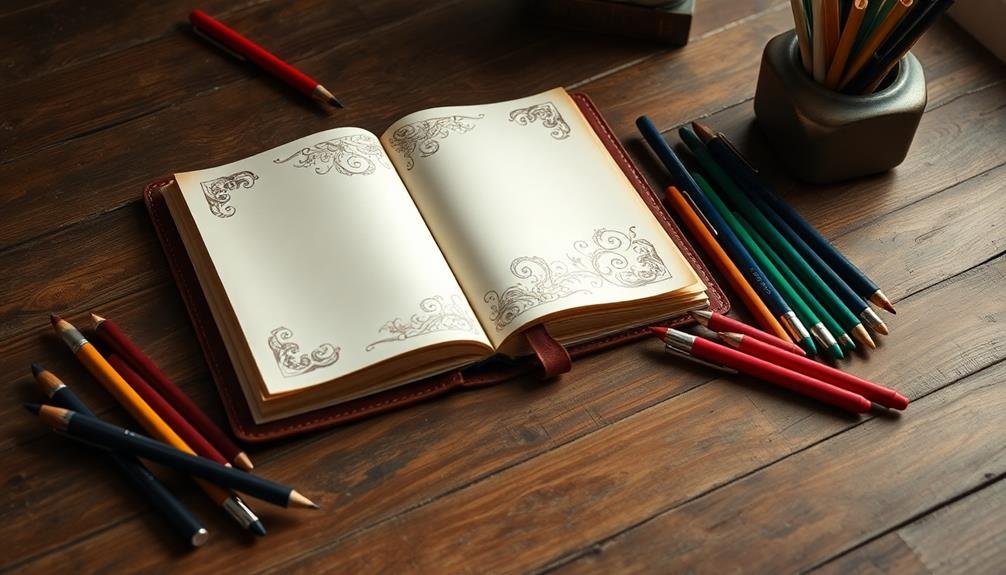
Explore the power of positive self-talk through affirmation lettering practice in your journal.
You can create beautiful designs featuring uplifting phrases that resonate with you, reinforcing their message visually and mentally.
Don't forget to decorate your favorite mantras, adding colors and embellishments that bring joy and calm to your journaling experience.
Positive Self-Talk Designs
Choose a design style that appeals to you, like floral borders, geometric patterns, or watercolor backgrounds. Sketch your chosen affirmation in the center of the page, experimenting with different fonts and lettering styles.
Add decorative elements around the words to enhance their impact and make them visually striking.
Consider creating a dedicated section in your journal for these positive self-talk designs. Each time you feel anxious or overwhelmed, flip to this section and spend a few minutes focusing on the affirmations you've created.
You can also use these designs as templates for daily practice, rewriting the affirmations to reinforce their message. By regularly engaging with these visual representations of positive self-talk, you'll strengthen your ability to combat negative thoughts and cultivate a more optimistic outlook.
Decorate Favorite Mantras
Why not take your favorite mantras and turn them into beautiful works of art? Decorating your mantras can be a soothing and creative way to reinforce positive thoughts while managing anxiety. Choose a mantra that resonates with you and experiment with different lettering styles, colors, and embellishments to bring it to life on your journal pages.
Start by selecting a few mantras that you find particularly powerful or comforting. Practice writing them in various fonts, from flowing cursive to bold block letters. As you decorate, focus on the meaning behind the words, allowing their message to sink in deeply.
You can enhance your mantras with:
- Intricate borders or frames
- Watercolor backgrounds or washes
- Doodles and illustrations that represent the mantra's meaning
- Metallic accents or glitter for added sparkle
Don't worry about perfection; the act of creating is just as important as the final result. As you regularly engage in this practice, you'll not only improve your lettering skills but also strengthen your connection to these positive affirmations.
Your decorated mantras will serve as visual reminders of your inner strength and resilience whenever you need them most.
Nature-Inspired Watercolor Spreads
Many journalers find solace in nature-inspired watercolor spreads, which can be a soothing and meditative way to ease anxiety. To create these calming pages, you'll need watercolors, brushes, and watercolor paper or a journal with thick pages.
Start by choosing natural elements that bring you peace, such as flowers, leaves, or landscapes. Sketch these lightly with pencil, or simply let your brush guide you. As you paint, focus on the gentle strokes and the way colors blend on the page. Don't aim for perfection; instead, embrace the organic, flowing nature of watercolors.
Experiment with different techniques like wet-on-wet or salt textures to add depth to your spreads. You can also incorporate pressed flowers or leaves for added texture. Consider adding calming quotes or affirmations related to nature to enhance the spread's therapeutic effect.
Use these spreads as a visual reminder of the tranquility found in nature. When you're feeling anxious, flip to these pages and let the serene images transport you to a calmer state of mind.
With practice, you'll find that creating these spreads becomes a form of mindfulness, helping to quiet racing thoughts and promote relaxation.
Emotion Color Coding System
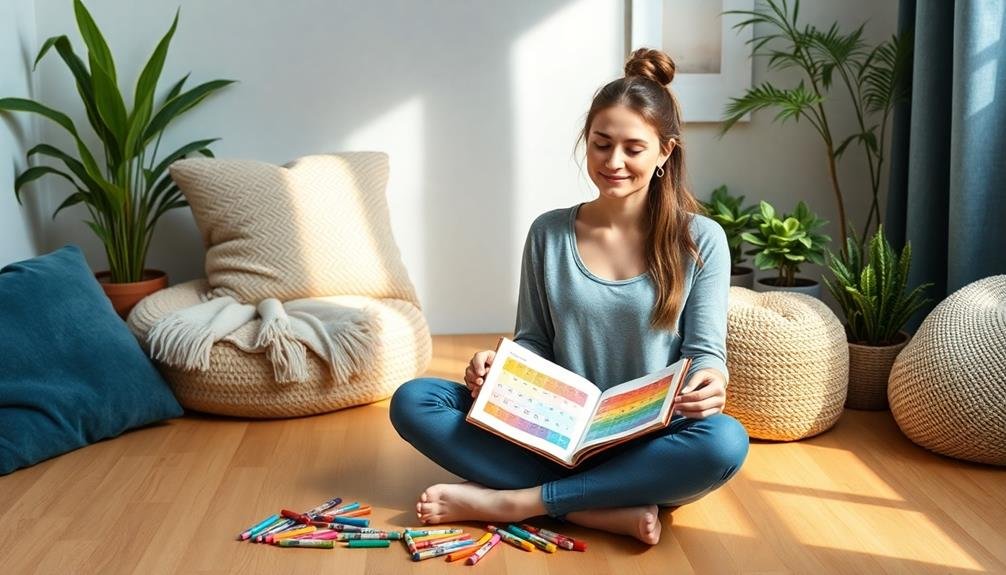
Developing an emotion color coding system can help you tap into your feelings and track your emotional state over time. Choose colors that resonate with specific emotions for you, such as red for anger, blue for sadness, or yellow for happiness. As you journal, use these colors to highlight words, create borders, or fill entire pages to represent your emotional state.
This visual approach allows you to quickly identify patterns in your mood and anxiety levels. You'll be able to see at a glance which emotions have been dominant over time, helping you recognize triggers and track progress in managing your anxiety.
To enhance your color coding system, consider:
- Creating a color key at the front of your journal
- Using different shades of each color to represent intensity
- Combining colors for complex emotions
- Incorporating symbols or doodles alongside colors
Don't limit yourself to traditional color associations; trust your instincts and choose colors that feel right for you. As you become more familiar with your personal color code, you'll find it easier to express and process your emotions through your journaling practice, ultimately contributing to anxiety relief and improved self-awareness.
Breathing Technique Trackers
Breathing technique trackers offer a creative way to visualize and record your mindful breathing practices.
You can create visual breath pattern logs to chart different breathing exercises you've tried and their effects on your anxiety levels.
Visual Breath Pattern Logs
Incorporating visual elements into your journaling practice, breath pattern logs offer a unique way to track and improve your breathing techniques. These logs allow you to visually represent your breath patterns, helping you become more aware of your breathing habits and progress over time. You can create simple diagrams or more elaborate designs to illustrate your inhalations, exhalations, and any pauses in between.
To start your visual breath pattern log, choose a method that resonates with you:
- Wave patterns: Draw undulating lines to represent the flow of your breath
- Circular diagrams: Use concentric circles to show the depth and duration of each breath
- Color-coded grids: Assign colors to different aspects of your breathing and fill in squares
- Mandala-style patterns: Create intricate designs that expand and contract with your breath
As you consistently log your breath patterns, you'll gain insights into your breathing habits and how they relate to your anxiety levels.
You might notice patterns emerging, such as shallow breathing during stressful periods or improved breath control after regular practice. This visual approach can make the abstract concept of breath more tangible and help you stay motivated in your anxiety management journey.
Daily Mindful Breathing Records
While visual breath pattern logs offer a creative approach to tracking your breathing, daily mindful breathing records provide a structured method for monitoring your progress with various breathing techniques. These records help you maintain consistency in your practice and observe improvements over time.
To create a daily mindful breathing record, set up a table in your journal with columns for the date, technique used, duration, and any observations. Here's an example:
| Date | Technique | Duration | Observations |
|---|---|---|---|
| 5/1 | 4-7-8 | 5 min | Felt calmer |
| 5/2 | Box | 7 min | Sleepy |
| 5/3 | Ujjayi | 10 min | Energized |
As you fill in your record each day, you'll notice patterns emerging. You might find that certain techniques work better for you at different times of the day or in specific situations. This insight can help you tailor your breathing practice to maximize its anxiety-relieving benefits. Additionally, seeing your consistent effort documented can be motivating and reassuring, especially on days when you're feeling particularly anxious.
Worry Release Through Writing
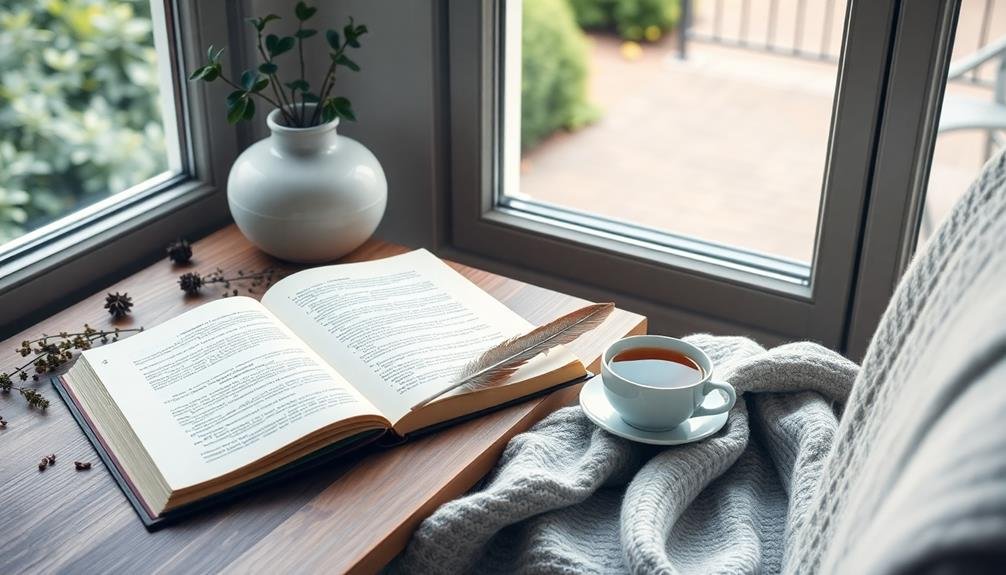
Worry release through writing often proves to be a powerful tool for managing anxiety. This technique allows you to pour your concerns onto paper, freeing your mind from the constant cycle of worrisome thoughts. As you write, you'll find yourself gaining clarity and perspective on your anxieties, making them feel more manageable.
To practice worry release writing, set aside dedicated time each day. Find a quiet space where you won't be interrupted, and let your thoughts flow freely onto the page. Don't worry about grammar, spelling, or structure; the goal is to express your anxieties without judgment.
Consider incorporating these elements into your worry release writing:
- Stream of consciousness: Write whatever comes to mind without filtering
- Worst-case scenario exploration: Examine your fears in detail
- Solution brainstorming: Jot down potential ways to address your worries
- Gratitude reflection: Balance anxieties with positive aspects of your life
Positive Memory Scrapbook Pages
Create a positive memory scrapbook in your journal to boost your mood and reduce anxiety.
Start by selecting memories that bring you joy and comfort, then design a layout that captures the essence of each moment.
Personalize your pages with photographs, ticket stubs, or small mementos to make your scrapbook a tangible reminder of happiness.
Choosing Meaningful Memories
Through the lens of positive memories, you can create a powerful tool for anxiety relief. When selecting memories for your scrapbook pages, focus on those that evoke strong positive emotions and a sense of calm. Consider moments when you felt safe, loved, or accomplished. These memories can serve as anchors during anxious times, reminding you of your resilience and happiness.
To choose meaningful memories, reflect on:
- Times you overcame challenges
- Moments of genuine connection with loved ones
- Experiences that brought you joy or wonder
- Personal achievements, big or small
Don't limit yourself to grand events; sometimes, the simplest memories can be the most comforting. A quiet afternoon with a friend, the satisfaction of completing a project, or the serenity of a beautiful sunset can all be powerful anxiety-relief tools.
As you select these memories, try to recall the sensory details associated with them. What did you see, hear, smell, or feel? Including these details in your scrapbook pages will help you immerse yourself in the positive experience when you revisit them, making them more effective for managing anxiety.
Designing Layout and Elements
Designing your positive memory scrapbook pages is where your creativity can truly shine. Start by choosing a color scheme that complements your chosen memories and evokes positive emotions. Soft, calming colors like pastels can be soothing, while vibrant hues might energize you.
Consider the layout of each page. You might opt for a clean, minimalist design or a more eclectic, collage-style approach. Use rulers and guidelines to guarantee your elements are properly aligned. Incorporate various textures to add depth and interest to your pages. Try using patterned papers, fabrics, or even natural elements like pressed flowers.
Don't forget to include meaningful text alongside your photos. Write short captions, quotes, or personal reflections that capture the essence of each memory. Experiment with different fonts and handwriting styles to add personality to your pages.
Embellishments can enhance your scrapbook's visual appeal. Use stickers, washi tape, stamps, or hand-drawn doodles to decorate your pages.
Adding Personal Touches
Your positive memory scrapbook becomes truly unique when you infuse it with personal touches. These elements not only make your journal more visually appealing but also enhance its emotional impact.
Consider incorporating mementos from special events, such as ticket stubs, postcards, or pressed flowers. You can also add personal photographs, either printed or as instant camera shots, to bring your memories to life.
Don't hesitate to get creative with your personal touches. You might:
- Use your own handwriting for captions or quotes
- Create custom stickers or stamps that represent your experiences
- Include small sketches or doodles that capture the essence of a memory
- Add fabric swatches or textured paper to engage multiple senses
Mindfulness Mandalas and Zentangles
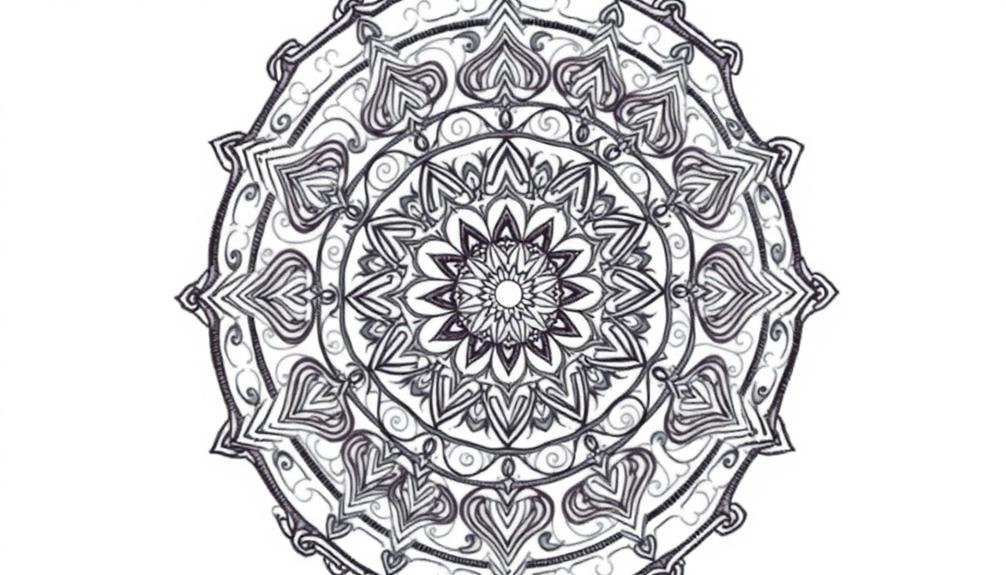
Mindfulness mandalas and zentangles offer a meditative approach to journaling that can greatly reduce anxiety. These intricate designs encourage focus and relaxation, allowing you to temporarily escape from worries and enter a state of flow.
To create a mandala, start with a circle and add symmetrical patterns radiating from the center. Zentangles, on the other hand, involve drawing structured patterns within a square frame. Both techniques promote mindfulness as you concentrate on each line and shape.
Here's a quick guide to get you started:
| Mandala | Zentangle | Benefits |
|---|---|---|
| Circular | Square | Stress relief |
| Symmetrical | Freeform | Improved focus |
| Radial patterns | Structured patterns | Increased creativity |
| Color optional | Black and white | Boosted self-esteem |
| Symbolic | Abstract | Enhanced relaxation |
As you practice these techniques, you'll notice your mind becoming calmer and more centered. Don't worry about perfection; the process itself is what matters. Experiment with different patterns, shapes, and tools to find what works best for you. You'll soon discover that creating mandalas and zentangles can be a powerful tool for managing anxiety and promoting overall well-being.
Self-Care Routine Planner
A well-structured self-care routine can work wonders for managing anxiety and improving overall well-being. Creating a self-care routine planner in your journal can help you prioritize and track activities that nurture your mental and physical health.
Start by brainstorming activities that make you feel calm, energized, or fulfilled. Then, organize these activities into a weekly or daily schedule, ensuring you're addressing various aspects of self-care.
Consider including these elements in your self-care routine planner:
- Physical health: Exercise, nutrition, and sleep habits
- Mental health: Meditation, therapy appointments, and stress-relief techniques
- Social connections: Time with friends, family outings, or support group meetings
- Personal growth: Learning new skills, reading, or pursuing hobbies
As you use your self-care routine planner, you'll likely notice patterns in what works best for you. Don't be afraid to adjust your plan as needed.
Frequently Asked Questions
How Long Should I Spend on Creative Journaling Each Day?
You don't need to spend a set amount of time journaling daily. Start with 5-10 minutes and adjust based on your schedule and needs. It's more important to be consistent than to journal for long periods.
Can I Use Digital Tools for Creative Journaling, or Only Physical Materials?
You can absolutely use digital tools for creative journaling. While physical materials offer a tactile experience, digital apps and devices provide convenience and versatility. Choose what works best for you – there's no right or wrong approach.
What if I'm Not Artistic? Can I Still Benefit From Creative Journaling?
You don't need to be artistic to benefit from creative journaling. It's about self-expression, not perfection. You can use words, simple doodles, or even collages. The process itself is what's therapeutic, not the end result.
Is It Necessary to Share My Journal Entries With Others?
No, it's not necessary to share your journal entries. Your journal is a private space for self-reflection and personal growth. You can keep it entirely to yourself if that's what makes you most comfortable and helps you express freely.
How Can I Incorporate Creative Journaling Into My Existing Self-Care Routine?
You can easily integrate creative journaling into your self-care routine. Set aside time daily, use prompts for inspiration, and experiment with different techniques. Try combining it with other relaxing activities like meditation or nature walks for added benefits.
In Summary
You've now got a toolbox of creative journaling techniques to help manage your anxiety. Whether you're expressing gratitude, doodling mindfully, or releasing worries through writing, these activities can bring calm to your daily life. Don't be afraid to experiment and find what works best for you. Remember, consistency is key. Make journaling a regular part of your self-care routine, and you'll likely see positive changes in your mental well-being over time.

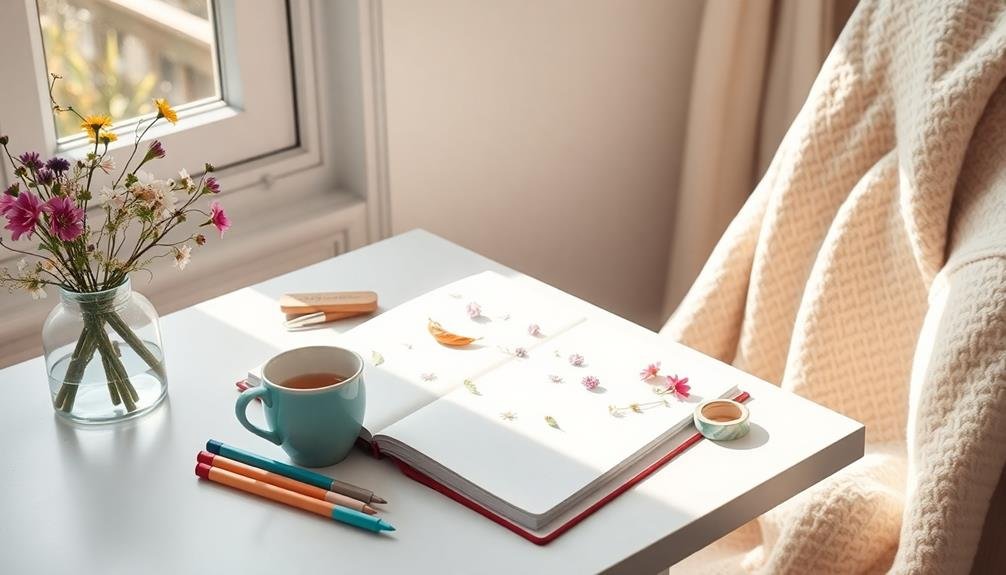



Leave a Reply